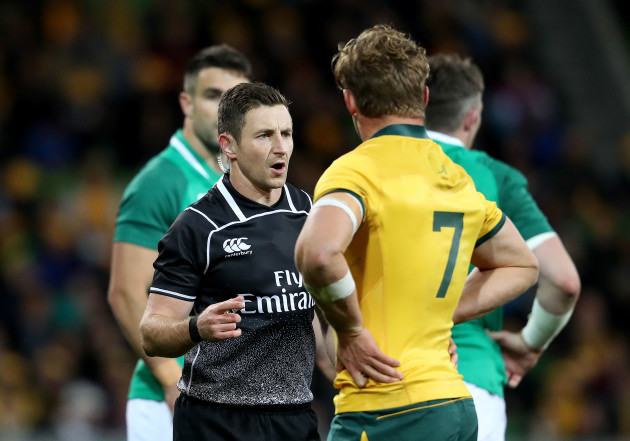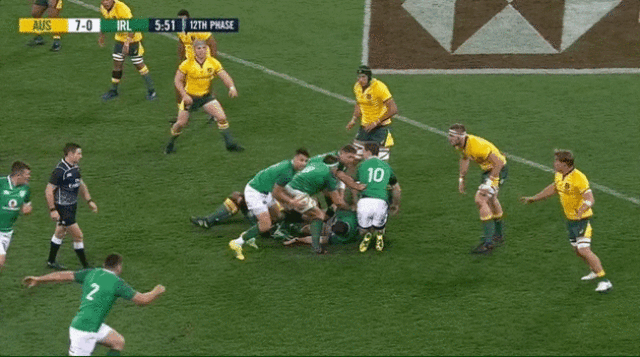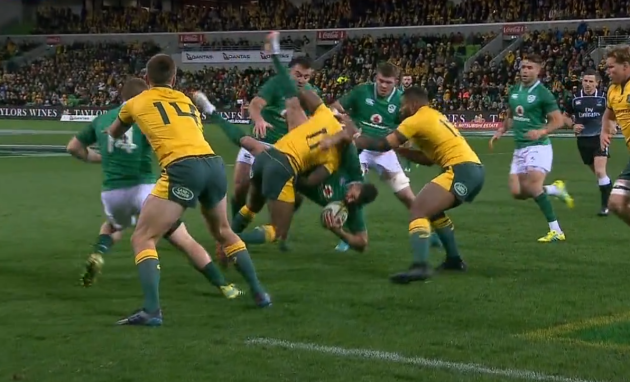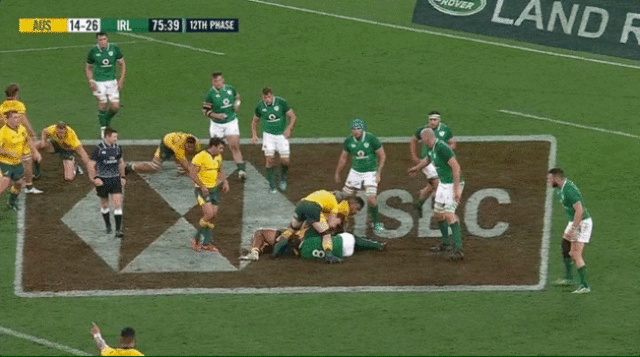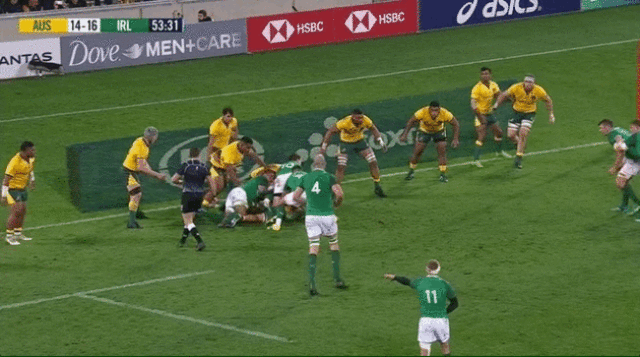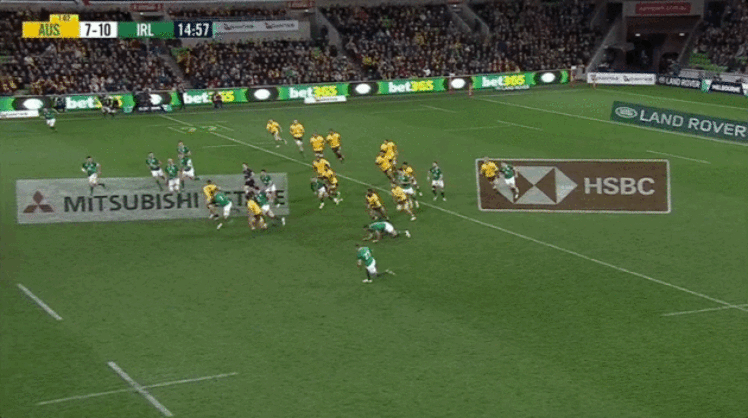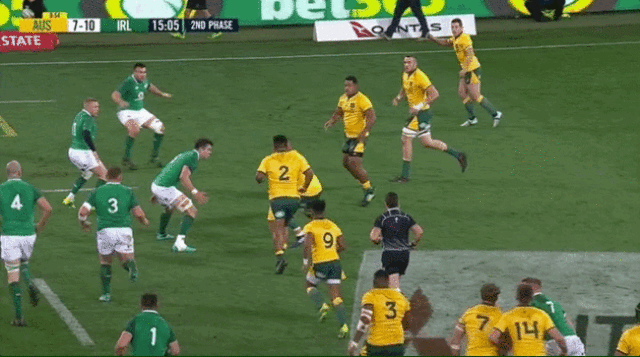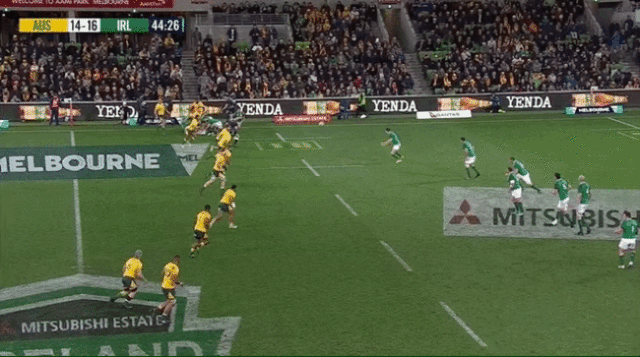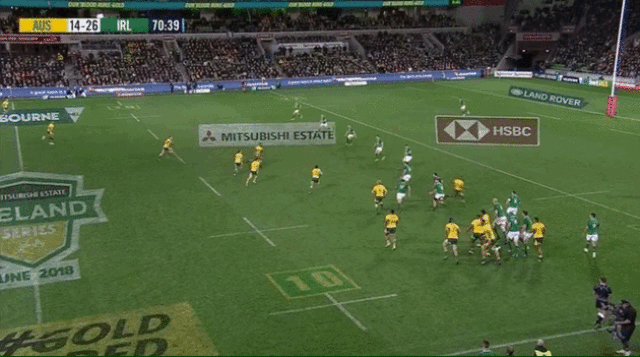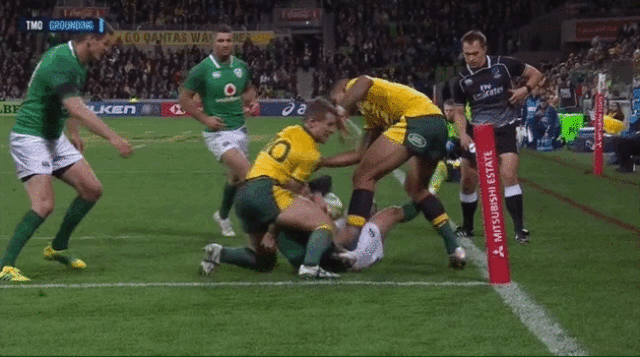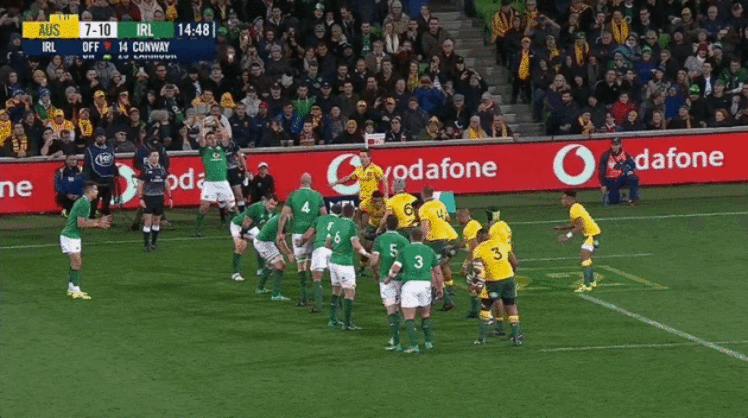SIMILARLY TO OUR previous two referee reviews, this piece will examine the performance of the match officials during Ireland’s win over the Wallabies last weekend.
The article will outline the circumstances of each situation within the game before a currently active guest referee adds their analysis of the incidents. Their contributions will be marked as ’referee’s view‘.
It’s worth stressing again that the intention here is not to harshly criticise or call-out match officials.
We hope that by examining the big calls and a few of the less obvious decisions, we can improve our knowledge of the application of the laws of the game and help our readers to do the same.
Match officials play a key role in deciding the outcome of rugby games and positive, non-aggressive discussion of this element of the sport is something The42 wants to encourage.
Overview:
Ireland beat Australia 26-21 at AAMI Park in Melbourne last weekend in what was a high-tempo contest with a ball-in-play time of 32 minutes and 43 seconds.
Referee Paul Williams awarded 27 penalties in total, with Australia giving up 15 and Ireland conceding 12.
There were three yellow cards in the game.
Ireland’s Cian Healy was sin-binned for collapsing a Wallabies maul, for which Williams also awarded a penalty try, while Ireland replacement loosehead prop Jack McGrath was shown yellow for a deliberate knock-on while off his feet in a ruck.
Wallabies wing Marika Koroibete was yellow-carded for a dangerous tackle.
Koroibete yellow
Ireland are attacking in the sixth minute when Conor Murray skip passes to Rob Kearney, who is tackled by Wallabies wing Marika Koroibete.
Click here if you cannot view the clip above
Referee Williams immediately sounds his whistle to halt play and speaks to assistant referee Marius van der Westhuizen, asking, “You got anything? Might have a look at the point of contact.”
Van der Westhuizen: “Yeah, I’ve got a clear lift and turn, just got to look for point of contact.”
Williams asks for a “TMO check” and tells television match official Ben Skeen, “What I’m looking at is a lifting tackle here, I just want you to have a look at potential foul play, please.”
After three replays, Williams says, “OK, thanks Ben” and van der Westhuizen confirms his input: “Lands dangerously, but not on the neck.”
Williams calls across Koroibete and says, “It’s a clear lifting tackle and he’s landed dangerously, it’s a yellow card.”
Law 9.18 applies here:
Referee’s view:
“There is a good process between the TMO and referee here and they get the correct outcome.
“One point to highlight particularly is that the referee takes full control. This is a good yellow card decision.”
McGrath yellow
Australia are attacking in the Ireland 22 in the 76th minute when scrum-half Nick Phipps appears to knock the ball on at the base of a ruck.
Click here if you cannot view the clip above
Referee Williams indicates a scrum to Ireland, but within a few seconds his assistant referee, Pascal Gaüzère, calls for the Williams’ attention.
Gaüzère says,”Green off feet, knocks the ball deliberately, so there is a knock-on after,” and Williams responds, “So potential foul play? Do you want to have a check?”
Williams asks TMO Skeen to check for “a deliberate knock-on by Green.”
After seeing an Irish player making contact with the ball, Skeen confirms, “We do have a deliberate knock-on, we’re just now going to get video footage of the [player's] number.”
“Paul, it is Green number 17,” confirms Skeen soon after.
Williams calls over Jack McGrath and says, “It’s a deliberate action, you’ve deliberately knocked the ball on and it’s a yellow card.”
Law 11.3 applies here:
Referee’s view:
“This is excellent work by the team of officials, with a great spot by the assistant referee and then a seamless process to confirm the offence and the player involved.
“The match officials took their time and got the right decision, another correct yellow card.”
Healy yellow:
The Wallabies set up a maul 10 metres out from Ireland’s tryline and surge forward, before Cian Healy brings it to ground.
Click here if you cannot view the clip above
Williams awards the Wallabies a penalty try and seeks out Healy and saying, “Yellow card, intentionally collapsing.”
Referee’s view:
“The penalty try is the correct decision here, as Green 1 begins to collapse the maul just before the tryline.
“However, it is very rare now that a referee at the top level goes to the pocket for a yellow card after a penalty try from a maul, unless there were multiple penalty kicks or a warning just before.
“In my eyes, this is a harsh yellow card.
“Compare this decision to the lack of a yellow card for Gold 7 just before Green 3 scores a try.
Click here if you cannot view the clip above
“There is another penalty advantage against Gold for not rolling away here after Gold have accumulated a few penalties in their own 22, so why not give the yellow card here, for the collapsed maul, or at least warn the Gold captain?
“I felt that the process of upgrading in sanctioning to yellow cards was poor at times in this game.
“For example, the offence below should be an easy yellow card decision.
Click here if you cannot view the clip above
“This is cynical play from Gold 10 and stops a clear linebreak.
“It wasn’t the first deliberate knock-on from Gold in the game either.”
Rolling away
The Wallabies are attacking out of their own half after an Israel Folau intercept of a Keith Earls pass, but Dan Leavy tackles Folau.
Click here if you cannot view the clip above
Referee’s view:
“This is a penalty kick for Gold, in my opinion. Green 7 makes the tackle and needs to roll out left or right, not back into the Gold 9′s channel.
“Gold 7 may be trying to pin Green 7, but the first offence is Green 7 rolling into the space. Sanctioning that offence early in the game would mean he doesn’t get in that space again.
“Imagine a clock and if the player rolls out of the tackle to 11, 12 or 1 – he is taking the space and deserves to be penalised.
“Also look at the next breakdown and the actions of Green 5.
Click here if you cannot view the clip above
“Green 5 is the tackler and then as he gets back to his feet, his actions are enough to slow down the Gold clear out and give Green 6 that extra second to lock on to the ball and be rewarded.
“For me, Green 6 isn’t ever really solidly on his feet here, with his hands going to ground in front of the ball before he gets onto it.”
Tackles off the ball
Ireland are attacking in their own half and Johnny Sexton fires a pass to Niall Scannell, but Australia hooker Tolu Latu makes contact with Jordi Murphy off the ball.
Click here if you cannot view the clip above
Referee’s view:
“There have been lots of tackles off the ball in the two games of this series. This example is the second time from Australia in the game and it is cynical play by Gold 16.
“It’s a good penalty kick decision from the referee, but this really needs a sterner warning to Gold. The referee says ‘Michael, that’s two’ to the Gold captain, but what does that really mean?
“Also, the consistency needs to be strong in this area.
“Look at the actions of Green 13 on Gold 10 below, for example.
Click here if you cannot view the clip above
“Green 13 clearly takes out Gold 10 off the ball and this is a penalty kick. The referee needs help from his assistants in this area.
“There was another potential penalty offence of a similar nature when Green had a possible try ruled out.
Click here if you cannot view the clip above
“This was a very tough decision to make on the possible grounding and was managed well again, but Green 6 is very lucky he wasn’t sanctioned for his actions on Gold 10.”
Scrum:
Ireland have the put-in to the scrum near their own 22-metre line but the scrum collapses after Conor Murray feeds the ball in.
Click here if you cannot view the clip above
Referee’s view:
“This is a good refereeing decision against Green 18, who ‘pancakes’ after the ball is put in – he goes flat on his face after overextending and losing the contest.
“There was another excellent refereeing decision at the scrum in the 12th minute, when Gold 1 and 3 both came under pressure and folded down, resulting in a penalty to Green.
“One other point on the scrum area was that the referee blew the whistle to signal a scrum to Green just before the half-time siren, so the scrum should have been played.”
Leaving the lineout:
Ireland have an attacking lineout in the Australia half and Cian Healy lines up at the front of the lineout.
Click here if you cannot view the clip above
Referee’s view:
“I just wanted to point out that knowledge of the laws is important for players and coaches, as much as match officials.
“Watch the actions of Green 1 here. He leaves the lineout just after the ball has been thrown in and works around to create an attacking option.
“This is a good application of the law from the player and in the design of the set-piece.
“When the ball leaves the hooker’s hands the lineout is over. Green 1 only leaves the lineout after the ball leaves the hands of Green 2.”
What did you make of these decisions and the refereeing overall last weekend?
We would ask that people hold back from personal or overly harsh criticism, but let us know your take on the incidents above or any others from last weekend’s game. What was well done by the refereeing team and what could have been better?
The42 is on Instagram! Tap the button below on your phone to follow us!
